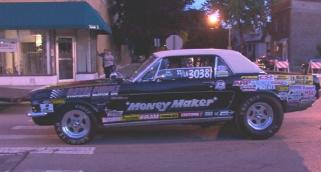|
Author
|
Topic: Dual diaphragm vacuum advance?
|
Fastback68
Gearhead Posts: 4511
From: Sucat, Paranaque, Philippines
Registered: Jul 99
|
 posted 05-19-2003 02:24 AM
posted 05-19-2003 02:24 AM
 

A year ago, when I knew nothing about vacuum, I fitted this distributor vacuum advance, and never even noticed that little hole in it! Osborn's says a 68 302 4V auto came with a single diaphragm vacuum, but some other models came with the dual diaphragm.
Many questions!
1) Is this unit here (which a tag says came from a late '70s Ford) a dual diaphragm unit?
2) If so, should I plug that hole, or connect it someplace? Osborn's shows "maximum vaccuum routing" for hoses, in which the second diaphragm (i.e., the one this hole might be) for a 390, for example, ends up going to a vaccuum tree at the back of the intake manifold. If my unit is a dual diaphragm, and if I can't just plug it, is it OK to connect it with a tee to the hose coming from the front, and then directly to the carb?
4) Last but by no means least, what is the purpose of a dual diaphragm unit and why did the 302 4v auto not need one?
Thanks as always,
Simon
[This message has been edited by Fastback68 (edited 05-19-2003).]
|
Huskinhano
Journeyman Posts: 57
From: Montvale, NJ.
Registered: Nov 2002
|
 posted 05-19-2003 06:20 AM
posted 05-19-2003 06:20 AM
 
The dual diaphram units were mostly used on late 60's to about '74 cars,not just Ford but all car makers used them.This was a polution device. At idle, the back port would be in operation. Engine manifold vacuum would retard timing and the front diaphram would be connected to a ported vacuum. As engine RPM's increased, so would the port vacuum. This would advance the timing. Both of these vacuums would usually be connected to some sort of temperature controls as well. In addition the vacuum advance side would be connected to the transmisssion as well so the only time you'd have vacuum advance would be in high gear! Pretty bleak times, heh? Yes the cars use to run like **** back then with this stuff along with horrible gas milage and hot running engines. This was primative emmission controls. The dual vacuum canister was for the most part done by '75 when catalytic converters first made their intro. Yes, a lot of the '75's had much better drivability. I use to work in a Chevy dealership back then. When the cat converters came out, almost all the polution devices were gone. The vacuum advance was directly connected to the carb, no dual canister. the only device was the EGR valve. The engines were a lot cleaner looking! You do not need to do anything to that hole. Just leave it alone, you won't have any vacuum leaks if you leave it unplugged. [This message has been edited by Huskinhano (edited 05-19-2003).]
|
indyphil
Gearhead Posts: 3394
From: Senoia, G.A. USA
Registered: Jul 2002
|
 posted 05-19-2003 11:11 AM
posted 05-19-2003 11:11 AM
 
Simon,
My 68 289 had the dual diaphram system
It wasnt hooked up right when I got it.The system should include a thermostatic switch, which on the small block was screwed into the thermostat housing on the top. The manual says that this will turn off the vacuum retard in the case of a hot running engine, this helps the timing to advance and therefore helps prevent overheating. I have all these parts in my garage but chose to go to the simpler single system. I have the vacuum diagrams if you would like I could scan them My dual unit was smaller than the one shown in your photo, and actually had a port sticking out the back for the retard. My single hose system looks like your photo but there is an orange bung in the hole you have circled. Not sure but I think your unit is just designed for single operation, I think that hole maybe for something else (breather? maybe you can make adjustments through it?) If anyone is using this vacuum unit for dual operation please correct me. Simon I can take photos and post them on my website or email them to you if you like. ------------------
'68 coupe 289 C code
66 heads, edel 600cfm carb, performer intake, dual exhaust
| |
















